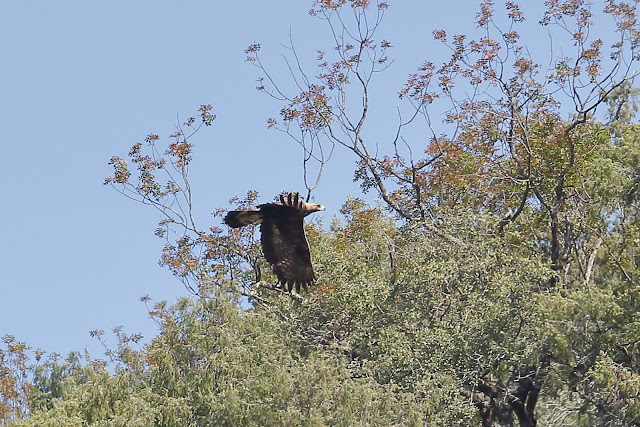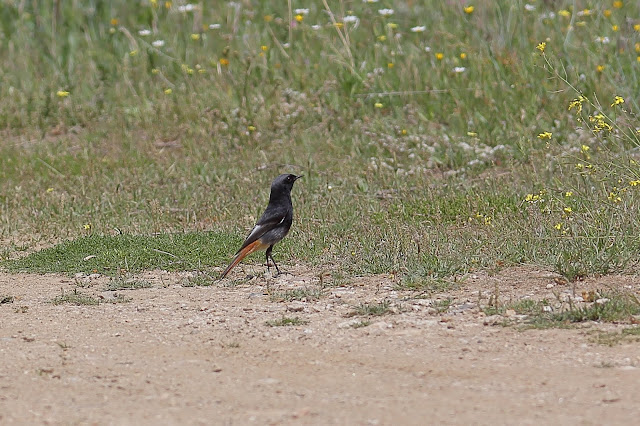Hola una vez más.
Hi again.
En el siguiente enlace podéis ver nuestros próximos viajes fotográficos y de observación de aves y mamíferos nacionales y al extranjero. Espero que os gusten y os animéis a venir conmigo. Una experiencia que nunca olvidareis.
Hi again.
En el siguiente enlace podéis ver nuestros próximos viajes fotográficos y de observación de aves y mamíferos nacionales y al extranjero. Espero que os gusten y os animéis a venir conmigo. Una experiencia que nunca olvidareis.
In the following link you can see our next national and foreign Birds and Mammals photographic and observation trips. I hope you like them and I encourage you to come with me. An experience that you will not forget.
En esta ocasión os muestro algunas de las aves que vimos en dos viajes. El primero de ellos a la Sierra Oeste y el otro al Parque Nacional Sierra de Guadarrama, ambos en las zonas de la Comunidad de Madrid.
On this occasion I show you some of the Birds we saw in two trips. The first of them to the Sierra Oeste and the other to the National Park of Sierra de Guadarrama, both in the areas of the Community of Madrid.
En ambos casos el tiempo fue bueno y las visitas eran a la carta, es decir, viajes privados.
In both cases the weather was good and the visits were a la carte, that is, private trips.
Viaje a la Sierra Oeste de Madrid 30 de Abril:
Trip to Sierra Oeste of Madrid April 30:
En este viaje los clientes querían ver aves rupícolas con especial predilección por las águilas imperiales ibéricas (Aquila
adalberti) y las águilas reales (Aquila
chrysaetos).
On this trip, the clients wanted to watch Cliff-nesting Birds with a special predilection for Spanish Imperial Eagle and Golden Eagles.
Lo que más me gusto de las dos excursiones fue poder contemplar a esta hembra de búho real (Bubo bubo). Esta pareja lleva ya varios años reproduciendo en un alféizar de una ventana en un chalet en mitad de una población. Es increible que hayan elegido este lugar para sacar adelante a sus polluelos.
Me comentaron que este año tiene tres pollos. Se puede ver que el lugar está monitorizado pero, que yo sepa, no es de visualización para todas las personas.
What I liked the most about the two excursions was being able to see this female owl (Bubo bubo). This couple has been playing for several years on a windowsill in a chalet in the middle of a town. It is incredible that they have chosen this place to move their chicks forward.
I was told that this year they have three chicks. You can see that the place is monitored but, as far as I know, it is not visualization for all people.
Nada más llegar a nuestro primer punto del viaje vimos a este trepador azul (Sitta
europaea) cantando primorosamente.
As soon as we reached our first trip spot we saw this European
Nuthatch singing beautifully.
Vimos bastantes escribanos montesino (Emberiza
cia) pero solo pude fotografiar a este y no muy bién.
We saw quite a few Rock
Buntings but I could only photograph this and not how I like it.
También vimos varias oropéndolas europeas (Oriolus
oriolus) pero ya sabéis lo esquivas que son estas aves. En la foto un macho.
We also saw several Golden
Oriole but you know how elusive these birds are. In the photo a male.
Otro.
Another one.
Los aviones roqueros (Ptyonoprogne
rupestris) estaban muy atareados.
Crag
Martins were very busy.
Cuando ya se habían descansado al sol bajaban a continuar construyendo sus nidos.
When they had rested in the sun, they descended to continue building their nests.
Este ruiseñor común (Luscinia
megarhynchos) cantaba primorosamente a la sombra de un pino.
This Rufous
Nightingale was singing beautifully in the shade of a Pine Tree.
Y cuando llegamos a su zona, mi vieja amiga el águila imperial ibérica (Aquila
adalberti) apareció. Siempre me gusta verla sobrevolar sin esfuerzo aparente a pesar de que le falten algunas plumas de ala izquierda.
And when we arrived in her area, my old friend the Spanish
Imperial Eagle appeared. I always like to see her fly by without apparent effort even though she lacks some left wing feathers.
Y su macho no andaba muy lejos.
And his male was not far away.
También vimos a esta hembra de águila real (Aquila
chrysaetos) subadulta. Me extrañó ver que estaba en el territorio de una pareja adulta de esta misma especie.
We also saw this female Golden
Eagle subadult. I was surprised to see that she was in the territory of an adult couple of this same species.
Y siguiéndola se levantó el macho adulto de la pareja que antes os mencionaba. Espero que la hembra adulta no haya sufrido ningún percance pues llevan produciéndose en la zona varios años.
Pues no perseguía a la hembra de antes si no que iba con ella.
Because he was not chasing the previous female but he was going with her.
Majestuosa ave.
Awesome Bird.
Macho de roquero solitario (Monticola
solitarius).
Male Blue Rock
Thrush.
En el camino de regreso a la furgoneta había otro ruiseñor común (Luscinia
megarhynchos) cantando. Pero esta vez a pleno sol, cosa que no suele ocurrir a menudo. Ellos prefieren estar a la sombra.
On the way back to the van there was another Rufous
Nightingale singing. But this time in full sun, something that does not happen often. They prefer to be in the shade.
También vimos algunas mariposas.
We also saw some butterflies.
Y algunas flores como esta orquídea silvestre. Esta creo que es la cañamón (Orchis mascula).
And some flowers like this wild orchid. This I think is the Early-purple Orchid.
Y esta otra que desconozco su nombre pero que es de gran belleza.
And this other one that I do not know its name but that is of great beauty.
Y volvimos a ver la pareja de águilas imperiales ibéricas (Aquila
adalberti).
And we saw again the pair of Spanish
Imperial Eagles.
Macho de lavandera cascadeña (Motacilla
cinerea).
Male Grey
Wagtail.
Que estaba capturando insectos para sus crías.
That he was catching insects for his chicks.
Arrendajo euroasiático (Garrulus
glandarius).
Eurasian
Jay.
Macho de colirrojo tizón (Phoenicurus
ochruros).
Male Black
Redstart.
En nuestro camino hacia un merendero para comer, pudimos ver otra pareja de águilas imperiales ibéricas (Aquila
adalberti).
On our way to a picnic area to eat we could see another pair of Spanish
Imperial Eagles.
Y una de ellas llevaba una parte de una presa en sus garras.
And one of them carried a part of a prey in its claws.
Un carbonero común (Parus
major) estaba muy atareado construyendo un nido encima de donde estábamos comiendo.
A Great Tit was very busy building a nest on top of where we were eating.
Y después del almuerzo fuimos a ver una colonia de cría de buitres leonados (Gyps
fulvus). En el vídeo se puede observar en su segunda parte a cabeza de un pollo detrás del adulto.
And after lunch we went to see a breeding colony of Griffon Vultures. In the video you can see in its second part the head of a chick behind the adult.
De esta pareja de búhos reales (Bubo bubo) ya os he hablado al comienzo de este relato. Parecía muy entretenido mirando lo que ocurría dentro de la vivienda.
I have already spoken of this pair of Eagle Owls at the beginning of this post. She seemed very entertaining looking at what was happening inside the house.
Ha pasado un tiempo desde que ella perdió su ojo izquierdo, pero continúa criando exitosamente cada año. La pérdida del ojo ocurrió cuando ya se estaba reproduciendo en este lugar. Han estado utilizando este extraño lugar para reproducirse desde 2010.
It has been a while since she lost his left eye but she continues to raise successfully every year. The loss of the eye occurred when she was already breeding in this place. They have been using this strange place to breed since 2010.
Y no muy lejos de allí vimos una pareja de pardillos comunes (Carduelis
cannabina). En la foto el macho.
And not far from there we saw a pair of Common Linnets. In the photo the male.
Bonita ave.
Beautiful Bird.
Viaje al Parque Nacional Sierra de Guadarrama 13 de Mayo:
Trip to the Sierra de Guadarrama National Park May 13:
En este viaje los clientes querían conocer algunos lugares de este bello paraje de la geografía Madrileña y la aves que se pueden ver en ellos.
In this trip the clients wanted to know some places of this beautiful place of the Madrilenian Geography and the Birds that can be seen in them.
El primer ave del día que se dignó a posar para la cámara fue este petirrojo europeo (Erithacus
rubecula) que luego medí cuenta al revelar la foto que estaba anillado.
The first bird of the day that wanted to pose for the camera was this European robin (Erithacus rubecula) that I later counted by revealing the photo that was ringed.
Vimos bastantes verderones serranos (Serinus
citrinella) pero muy lejos y la mayoría en vuelo. Cuando los clientes entraron a tomar un café vino una pareja y se posó donde yo estaba. Fotografié al macho. Una pena que no volvieran estar tan cerca.
We saw a lot of Citril
Finch but very far and most of them in flight. When the customers came in for a coffee, a couple came and settled down where I was. I photographed the male. A pity they did not come back so close.
Hubo bastante movimiento de buitres negros (Aegypius
monachus).
There was quite a pass of Black Vultures.
Pero solo vimos un abejero europeo (Pernis
apivorus).
But we only saw an European
Honey-buzzard.
Esta pareja de serínes verdecillos (Serinus
serinus) estaba construyendo su nido.
This pair of European
Serin was building its nest.
Vimos bastantes acentores comunes (Prunella
modularis) pero ninguno se posó donde yo quería.
We saw quite a few Dunnocks but none settled where I wanted.
Cuervo grande (Corvus corax).
Common
Raven.
Otro en vuelo.
Another one in flight.
Pasamos un buen rato intentando fotografiar a las inquietas mariposas. En la foto una ortiguera (Aglais urticae).
We had a good time trying to photograph the restless butterflies. In the photo a Small Tortoiseshell.
Y esta lagartija que me llamó la atención por tener lunares azules en sus flancos pero que desconozco su nombre.
And this lizard that caught my eye for having blue spots on its flanks but I do not know its name.
Continuamos visitando otras partes del Parque y primero oí y luego pudimos localizar a una pareja de reyezuelos listados (Regulus
ignicapilla). Es muy importante conocer el canto de las aves para luego poder localizarlas.
We continued visiting other parts of the Park and first I heard and then we were able to spot a pair of Firecrest. It is very important to know the Birds songs so then you are able to locate them.
Luego decidí ir a ver si podíamos ver a algunas de las escurridizas currucas. Enseguida pude oír el canto de la curruca mirlona (Sylvia hortensis).
Then I decided to go and see if we could spot some of the elusive Warblers. Right away I could hear the song of the Western Orphean Warbler.
Bajo mi punto de vista es la más difícil de fotografiar pues es sumamente tímida.
From my point of view it is the most difficult to photograph because it is extremely timid.
Al final pude sacarla sin ninguna rama por el medio.
At the end I could photograph it without any branch in front of it.
Mientras almorzabamos, escuche el tamborileo de un pico menor (Dryobates
minor).
While we were having lunch, I hear the drumming of a Lesser Spotted
Woodpecker.
No tardamos mucho en encontrar el causante del ruido. Era un precioso macho de esta especie.
It did not take long to find the cause of the noise. He was a precious male of this species.
Por suerte pude encontrar un hueco entre las ramas para fotografiarlo.
Luckily I could find a gap between the branches to photograph him.
Esta fue la toma que más me gusta de ese día.
This was the shot I like most of that day.
Pero sin lugar a dudas la que más colaboró en este día de todas las aves que vimos fue esta curruca mosquitera (Sylvia
borin).
But without doubt the most collaborate of all the birds we saw this day was this Garden Warbler.
Después de que se acostumbrara a nuestra presencia y dejar una distancia en la que se encontraba cómoda con nuestra presencia, pude sacar estas fotos.
After he got used to us and left a distance where he was comfortable with our presence, I was able to take these pictures.
Se me olvidaba comentaros que lo primero que hago cuando veo a una especie que quiero fotografiar, lo primero que hago es buscar la posición más favorable con respecto a la luz y luego comienza el lento acercamiento.
I forgot to tell you that the first thing I do when I see a species that I want to photograph, the first thing I do is look for the most favorable position with respect to light and then I start a slow approach.
Sin embargo, los arrendajos euroasiáticos (Garrulus
glandarius) no me permitieron ningún tipo de las acciones que antes os he comentado.
However, the Eurasian Jays did not allow me any of the actions that I mentioned before.
Después nos trasladamos a zonas altas para ver que había este año por allí. Encontré que había muy pocas aves y debía ser que como todo estaba muy seco no tenían comida y por eso no había ni tantas ni las mismas especies que otros años. En la foto un escribano montesino (Emberiza
cia).
Then we moved to high areas to see what was there this year. I found that there were very few birds and it must be that, since everything was very dry, they had no food and therefore there were not as many or the same species as other years. In the photo a Rock
Bunting.
Otro más.
Another one.
Había bastantes narcisos silvestres.
There were quite a few wild Daffodils.
Pudimos ver un subadulto de águila imperial ibérica (Aquila
adalberti).
We could watch a subadult of Spanish
Imperial Eagle.
Y en esta otra fotografía compartía cielo con un milano real (Milvus
milvus).
And in this other photograph it was flying next to a Red Kite.
Me gustó contemplar como la luna salía entre las montañas.
I liked to contemplate how the Moon came out above mountains.
Y cuando regresábamos a la furgoneta después de un paseo vimos a una pareja de collalbas grises (Oenanthe
oenanthe). En la foto la hembra.
And while we were returning to the van after a walk we saw a pair of Northern
Wheatear. In the photo the female.
Y en esta otra el macho.
And in this other one the male.
En el camino de vuelta hicimos una parada en el embalse de Santillana a ver lo que podíamos ver. No saqué fotos pero hice estos dos vídeos. El primero es de un somormujo lavanco (Podiceps cristatus) que estaba incubando.
On the way back we made a stop at the Santillana Reservoir to see what we could spot. I did not take pictures but I made these two videos. The first one is of a Great Crested Grebe that was incubating.
Y este segundo de un martín pescador común (Alcedo
atthis) que estuvo muy poco tiempo en el poste.
And this second one of a Common Kingfisher that was a short time in this perch.
Y esto ha sido todo por hoy. Hasta pronto, amigos.
And this has been all for today. See you soon, friends.




























































































Magnificos avistamientos, la lagartija creo que es una roquera.
ResponderEliminarMuchas gracias Oscar por duplicado.
EliminarSaludos,
Luis Sitges
Fantásticas fotos, como siempre. La mariposa blanquecina que va detrás del ruiseñor me parece que es la Mariposa Manchas verdes, Glaucopsyche alexis. Compruébalo por si acaso.
ResponderEliminarEspero tu próximo reportaje
Muchs gracias Isabel, creo que estas en lo cierto. Me gusta mucho ver que mis seguidores se lean los correos y me ayuden a mejorarlo como en este caso.
EliminarUn saludo,
Luis